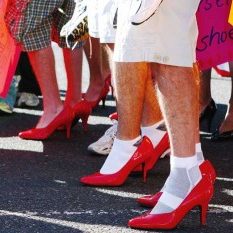Are “Walk a Mile in Her Shoes” sexual assault awareness events transphobic? This FORGE essay explores the question.
FORGE has received questions from a number of DV/SA organizations and community organizers asking whether the “Walk A Mile in Her Shoes” events are transphobic or otherwise offensive to transgender and gender non-conforming people.
Some trans people may, indeed, see these events as transphobic.
However, FORGE is far more concerned about the larger implications and aspects of these events. Most seriously, “Walk a Mile in Her Shoes” events focus only on female victims, casting men in one of two roles: 1. supporters-only of female survivors, and/or 2. perpetrators or potential perpetrators of violence against women. This focus of “gendered violence” obscures the fact that men and trans people of all gender identities and expressions are also victims, and that perpetrators may be female or transgender as well as male. By silencing and making invisible so many survivors, these gender-focused events often re-victimize everyone who doesn’t fit into the female-victim/male-perpetrator paradigm.
The “Walk a Mile In Her Shoes” events, on the other hand, often garner a lot of community support and interest and are a great opportunity to expand conversations about both violence and gender stereotypes. If all participants were encouraged to wear clothes that break stereotypes, conversations could focus around why such “rules” exist, how much sense they make, and why people dress in ways they find uncomfortable and/or unsafe. If the focus was less on men experiencing women’s high heels and more on the ways in which gender and violence intersect, these events could also address why sexual violence against men is even less talked about than sexual violence against women. If these events began addressing sexual violence in all of its many forms, it would become more possible for trans survivors — who are often totally silenced — to talk about their experiences, as well.
In our opinion, concerns about these events should focus less on whether they may be offensive to some trans people and more on whether they are re-victimizing more than a third of all victims by ignoring their very existence.

